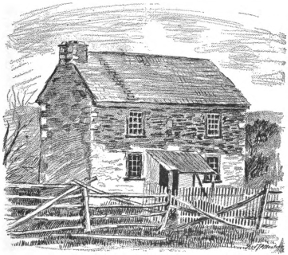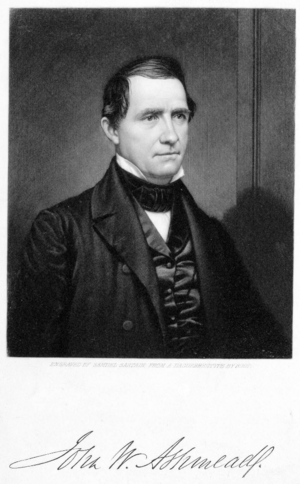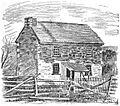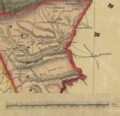Christiana Riot facts for kids
The Christiana Resistance, also known as the Christiana Riot, was a brave stand by free Black people and formerly enslaved people against a group trying to capture four escaped slaves. This event happened on September 11, 1851, in Christiana, Pennsylvania. A federal marshal led the group trying to capture the escaped slaves.
This happened after a new law, the Fugitive Slave Act of 1850, made it harder for enslaved people to escape. This law also meant that officials in free states, like Pennsylvania, had to help catch escaped slaves. It also added big fines for anyone who helped them.
The resistance took place at the home of William Parker, who had also escaped slavery. During the confrontation, shots were fired. Edward Gorsuch, the slave owner, was killed, and his group scattered. Many of the Black people involved quickly traveled to Canada, where they would be safe.
Later, 41 people, both Black and White, were accused of a very serious crime against the government. Castner Hanway, a white man, was the first to be tried in November 1851. The jury found him not guilty very quickly. After that, the accusations against everyone else were dropped. This event became a huge topic across the country and showed the growing tension between the North and the South. It was one of many important moments that led to the American Civil War.
Contents
Why Did the Christiana Resistance Happen?
Before slavery was ended in the United States, slave owners in the South wanted more help from the government to get back their escaped slaves. But in the free states of the North, many people and governments did not want to help. In fact, some state laws even protected people who had escaped slavery.
The Fugitive Slave Act of 1850
In 1850, the U.S. Congress passed the Fugitive Slave Act of 1850. This law allowed slave owners or their agents to chase and capture escaped slaves in free states. It also forced state officials to help catch these people. Anyone who helped an escaped slave could face six months in jail and a $1,000 fine. This was a lot of money back then!
Edward Gorsuch's Story
Edward Gorsuch was a farmer from Monkton, Maryland. He owned twelve slaves. He thought he was a good slave owner because he freed some of his slaves when they turned 28. He even offered them paid work after that.
Four of his older male slaves, Noah Buley, Nelson Ford, George Hammond, and Joshua Hammond, ran away to Pennsylvania. Pennsylvania was a free state. Gorsuch believed they had been tricked into leaving and would come back if he just talked to them.
Christiana: A Safe Place for Freedom Seekers
Christiana, in Lancaster County, Pennsylvania, was about 20 miles north of the Maryland border. It had become a safe place for people who had escaped slavery. Many free Black people also lived there.
Slave catchers often raided this area to try and capture escaped slaves. For 20 years, local Black communities had organized to protect themselves. Sometimes they stopped captures or even rescued people who had been caught. Others chose to flee even further north to Canada. William Parker, an escaped slave, was a leader of this resistance in 1851.
In Philadelphia, a group called the Special Secret Committee worked to gather information. They would warn people who were being hunted by slave catchers.
What Happened on September 11, 1851?
Edward Gorsuch heard that his four escaped slaves were in Lancaster County. On September 9, 1851, he got a federal warrant in Philadelphia to arrest George Hammond, Joshua Hammond, Nelson Ford, and Noah Buley. Henry Kline, a deputy Federal Marshal, was allowed to make the arrests. Gorsuch also hired two Philadelphia police officers, John Agan and Thompson Tully, to help.
The Journey to Christiana
A member of the Special Secret Committee, Samuel Williams, watched the group leave Philadelphia. He followed Kline and warned the Black community near Christiana that they were coming. Kline and his helpers knew they had been seen, so Agan and Tully went back to Philadelphia.
Kline met Gorsuch and his group in Sadsbury on September 10. The group heading into Christiana included Henry Kline, Edward Gorsuch, his son Dickinson Gorsuch, his nephew Joshua M. Gorsuch, his nephew Dr. Thomas Pierce, Nicholas T. Hutchings, and Nathan Nelson.
Just after midnight on September 11, Gorsuch's group started their raid with a hired guide. The guide led them to William Parker's house, where he said two escaped slaves were staying. The guide then left. It's not known if the guide purposely led them to this strong resistance area.
The Confrontation at Parker's House
William Parker knew the group was hunting slaves. In his house were his wife, Eliza; her sister, Hannah; Hannah's husband, Alexander Pinckney; and Abraham Johnson. Two visitors were also there: Joshua Kite (who was likely Nelson Ford, one of Gorsuch's escaped slaves) and Samuel Thompson (another of Gorsuch's escaped slaves). A white neighbor, Sarah Pownall, had warned them the night before to flee to Canada if the raiders came.
As the raiders approached Parker's house on a hill, they met Joshua Kite. Kite recognized Gorsuch and ran back to the house, shouting a warning. Parker and his household went to the second floor with their guns. They were in a good position to defend themselves.
The marshal's group surrounded the house. The U.S. Marshal announced they had the legal right to seize Nelson Ford. Parker and his household refused to give him up. Eliza Parker blew a horn to signal to local Black people that help was needed. Shots were fired, but no one was seriously hurt at first.
Dickinson Gorsuch and Kline suggested retreating to get more help, but Edward Gorsuch refused. The people inside the house asked for time. They talked about whether the two escaped slaves should surrender. Parker might have been delaying to wait for more people to arrive.
Reinforcements Arrive
Many armed men arrived, including Noah Buley, another of Gorsuch's escaped slaves. Several white neighbors also arrived, including Elijah Lewis, a shopkeeper, and Castner Hanway, a miller on horseback. Gorsuch thought the white men were leaders of the 75 to 150 Black people who arrived, many carrying guns.
Kline identified himself as a U.S. Marshal and talked to Hanway and Lewis. Hanway refused to help him make arrests. Hanway seemed to tell Kline's group to leave before anyone got hurt. According to Lewis, Hanway begged the Black people not to shoot.
Kline warned Hanway and Lewis that they were breaking a federal law by not helping him. When Edward Gorsuch faced his former slave Samuel Thompson, Thompson hit him. Gorsuch fell and was shot many times, which caused his death. His son Dickinson went to help him and was also shot multiple times. He managed to get away and was helped by a white man. Dickinson was taken to a nearby house and survived.
Lewis left when the violence started, as did Kline. Joshua Gorsuch and Thomas Pearce also fled. They were shot but managed to escape.
What Happened After the Christiana Resistance?
William Parker, Gorsuch's former slaves, and some other Black people fled north to Canada, where they found safety. In Rochester, New York, Parker stayed at the home of Frederick Douglass before taking a boat to Canada. Douglass helped the group get to Canada.
The Christiana Resistance was the latest in a series of conflicts over escaped slaves. The federal government had been struggling to enforce the Fugitive Slave Act. The death of a slave owner in Christiana was a big deal. President Millard Fillmore even called out the marines. They searched the area and arrested 36 Black people and five white people.
The government wanted to make an example of them. They accused them of a very serious crime against the government. Fillmore's actions were partly to calm down the South, where people were demanding the rioters be punished. This event was reported in newspapers all over the country. Northerners were also upset, seeing it as proof of the power of slavery reaching into the free North.
The Legal Cases
On October 6, 1851, accusations against 38 people were sent to a higher court. On November 14, 1851, a grand jury officially accused 41 people. Parker and some others were accused even though they had already fled.
The 41 people accused (most were Black, unless noted):
- Castner Hanway, White, miller
- Joseph Scarlet, White, farmer
- Elijah Lewis, White, storekeeper
- James Jackson, White, farmer
- George Williams
- Jacob Moore
- George Reed
- Benjamin Johnson
- Daniel Caulsberry
- Alson Pernsley
- William Brown, 2nd
- Henry Green
- Elijah Clark
- John Holliday
- William Williams
- Benjamin Pindergast
- John Morgan
- Ezekiel Thompson
- Thomas Butler
- Collister Wilson
- John Jackson
- William Brown
- Isaiah Clarkson
- Henry Simms
- Charles Hunter
- Lewis Gates
- Peter Woods
- Lewis Clarkson
- Nelson Carter
- William Parker (had already fled to Canada)
- John Berry
- William Berry
- Samuel Williams (found not guilty in a separate case)
- Josh Hammond (one of Gorsuch's escaped slaves)
- Henry Curtis
- Washington Williams
- William Thomas
- Nelson Ford (one of Gorsuch's escaped slaves)
- George Hammond (one of Gorsuch's escaped slaves)
- Noah Buley (one of Gorsuch's escaped slaves)
- Jacob R Townsend, White, merchant
The Trial of Castner Hanway
Castner Hanway, one of the white men accused, was tried first. His trial took place in Philadelphia from November 24 to December 11, 1851. Two important judges, Robert C. Grier and John K. Kane, led the trial. The government's lawyers were led by John W. Ashmead, joined by lawyers from Maryland. Thaddeus Stevens led the lawyers defending Hanway.
The jury found Hanway not guilty after only 15 minutes of thinking. After this, the government's lawyers dropped the accusations against everyone else. It was clear that they could not prove the serious crime they had accused them of. The defense lawyers had pointed out how silly it was to accuse a group of poorly armed farmers of starting a war against the United States.
What Happened to the People Involved?
William Parker's wife, Eliza, joined him in Canada in November 1851, and later their children came too. They settled in Buxton, Ontario. William Parker died before 1881, and Eliza died in May 1899. Some of their family members still live in Canada today.
Castner Hanway moved to Wilber, Nebraska, in 1878 and died there in 1893.
Edward Gorsuch's youngest son, Thomas Gorsuch, and his school friend John Wilkes Booth reportedly swore to get revenge for Edward's death.
Remembering the Christiana Resistance
In September 1911, a ceremony took place in Christiana to dedicate a memorial to the event. Family members of both sides were there, as well as descendants of Peter Woods, one of the people who had been accused.
Special medals were made. One medal, representing "Law," had a picture of President Millard Fillmore. It was given to Edward Gorsuch's granddaughter. The other medal, representing "Liberty," had a picture of Abraham Lincoln. It was given to Peter Woods, who was the last survivor of those accused.
In 1998, a historical marker was placed in Lancaster to remember the Christiana Resistance. It is one of many markers in Lancaster County that highlight important events related to the Underground Railroad. Another historical marker is at Gorsuch Tavern in Glencoe, Maryland, where Edward Gorsuch and his relatives planned their raid.
Images for kids









